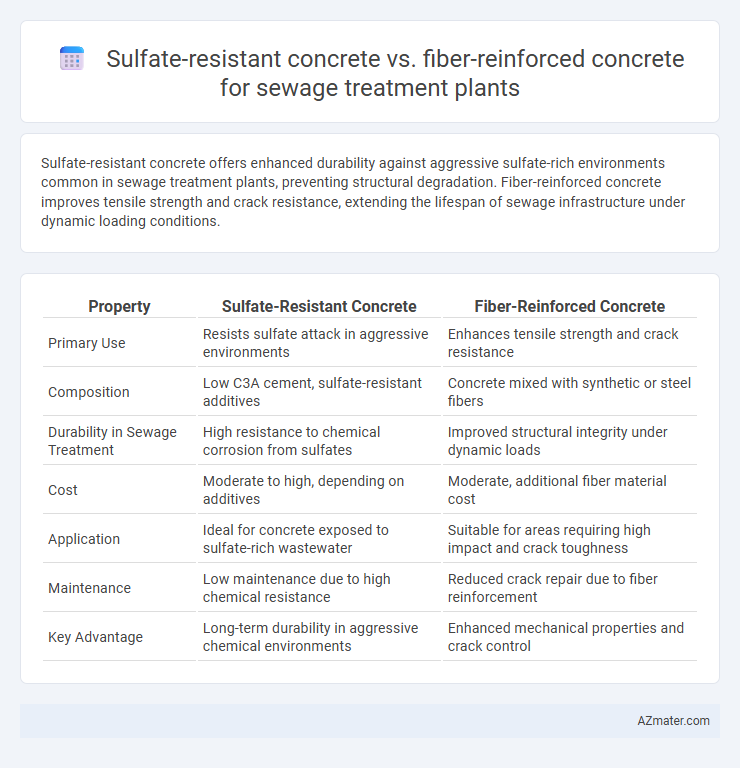Sulfate-resistant concrete offers enhanced durability against aggressive sulfate-rich environments common in sewage treatment plants, preventing structural degradation. Fiber-reinforced concrete improves tensile strength and crack resistance, extending the lifespan of sewage infrastructure under dynamic loading conditions.
Table of Comparison
| Property | Sulfate-Resistant Concrete | Fiber-Reinforced Concrete |
|---|---|---|
| Primary Use | Resists sulfate attack in aggressive environments | Enhances tensile strength and crack resistance |
| Composition | Low C3A cement, sulfate-resistant additives | Concrete mixed with synthetic or steel fibers |
| Durability in Sewage Treatment | High resistance to chemical corrosion from sulfates | Improved structural integrity under dynamic loads |
| Cost | Moderate to high, depending on additives | Moderate, additional fiber material cost |
| Application | Ideal for concrete exposed to sulfate-rich wastewater | Suitable for areas requiring high impact and crack toughness |
| Maintenance | Low maintenance due to high chemical resistance | Reduced crack repair due to fiber reinforcement |
| Key Advantage | Long-term durability in aggressive chemical environments | Enhanced mechanical properties and crack control |
Introduction to Sewage Treatment Plant Concrete Requirements
Sewage treatment plant concrete must possess high durability to withstand aggressive sulfate attacks and chemical corrosion common in wastewater environments. Sulfate-resistant concrete offers enhanced protection by incorporating low C3A cement and supplementary cementitious materials, reducing susceptibility to sulfate-induced deterioration. Fiber-reinforced concrete improves structural integrity through improved tensile strength and crack resistance but may require additional mix optimization to resist chemical degradation specific to sewage treatment applications.
Overview of Sulfate-Resistant Concrete
Sulfate-resistant concrete is engineered with low tricalcium aluminate content to withstand aggressive sulfate environments commonly found in sewage treatment plants. This type of concrete minimizes chemical deterioration caused by sulfate ions, enhancing durability and structural integrity in wastewater applications. Its formulation often includes supplementary cementitious materials like fly ash or slag to improve resistance and extend service life.
Key Properties of Fiber-Reinforced Concrete
Fiber-reinforced concrete (FRC) used in sewage treatment plants offers enhanced tensile strength, improved crack resistance, and superior durability under chemical exposure compared to sulfate-resistant concrete. The inclusion of synthetic or steel fibers enhances impact resistance and mitigates shrinkage, leading to longer service life in aggressive wastewater environments. High flexural strength and reduced permeability make FRC a preferred choice for structural components subjected to dynamic loads and corrosive sewage conditions.
Chemical Resistance in Aggressive Environments
Sulfate-resistant concrete exhibits superior chemical resistance against aggressive sulfate-rich environments commonly found in sewage treatment plants, preventing deterioration caused by sulfate attack. Fiber-reinforced concrete enhances mechanical durability and crack resistance but may require additional admixtures to improve chemical resistance against harsh wastewater chemicals. Selecting sulfate-resistant concrete ensures structural longevity in chemically aggressive settings, while fiber reinforcement optimizes toughness but does not inherently safeguard against sulfates.
Durability and Longevity Comparison
Sulfate-resistant concrete (SRC) is specifically engineered to withstand aggressive sulfate environments commonly found in sewage treatment plants, offering enhanced chemical resistance and preventing premature deterioration caused by sulfate attack. Fiber-reinforced concrete (FRC) improves mechanical properties such as tensile strength and crack control, which helps maintain structural integrity under dynamic and loading conditions typical in sewage processing facilities. For long-term durability, SRC excels in chemical resilience, while FRC contributes to improved toughness and crack resistance, making a combined approach optimal for maximizing lifespan and performance in harsh sewage plant environments.
Crack Control and Structural Integrity
Sulfate-resistant concrete offers enhanced durability in sewage treatment plants by preventing chemical attack from sulfate ions, significantly reducing crack formation and preserving structural integrity. Fiber-reinforced concrete improves crack control through the dispersion of microfibers, which enhance tensile strength and limit crack propagation under dynamic loading conditions. Combining sulfate-resistant cementitious materials with fiber reinforcement provides a synergistic approach to maintain longevity and resilience in aggressive wastewater environments.
Maintenance and Lifecycle Costs
Sulfate-resistant concrete significantly reduces maintenance costs in sewage treatment plants by resisting chemical attacks from sulfate-rich wastewater, thereby extending structural durability and lifecycle. Fiber-reinforced concrete enhances crack resistance and impact toughness, lowering the frequency and expense of repairs caused by mechanical stress and corrosion. Combining sulfate resistance with fiber reinforcement optimizes lifecycle costs through improved longevity and reduced maintenance interventions under harsh sewage treatment conditions.
Installation and Workability Factors
Sulfate-resistant concrete offers enhanced durability in sewage treatment plants by resisting sulfate attack, but it requires careful mixing and placement to maintain workability due to its specialized cement content. Fiber-reinforced concrete improves tensile strength and crack resistance, allowing for easier handling and reduced shrinkage during installation, which results in faster construction cycles. Choosing between these concretes depends on balancing the sulfate exposure severity against the need for improved mechanical performance and installation efficiency.
Environmental Impact and Sustainability
Sulfate-resistant concrete minimizes chemical degradation in aggressive sewage environments, extending structural lifespan and reducing repair frequency, which lowers environmental footprint through decreased material consumption. Fiber-reinforced concrete enhances durability and crack resistance, mitigating leakage and contamination risks, thereby supporting sustainable waste management practices in sewage treatment plants. Both concretes contribute to sustainability by improving resilience and reducing lifecycle environmental impacts, but sulfate-resistant concrete specifically targets sulfate attack prevalent in sewage settings.
Best Practices for Material Selection in Sewage Treatment Plants
Sulfate-resistant concrete (SRC) is specifically engineered to withstand high sulfate concentrations common in sewage treatment environments, enhancing durability and reducing maintenance costs. Fiber-reinforced concrete (FRC), incorporating materials like polypropylene or steel fibers, improves tensile strength and crack resistance, crucial for structural integrity under dynamic loads. Best practices in sewage treatment plant construction involve selecting SRC where chemical exposure is critical and using FRC in areas prone to mechanical stress, ensuring optimal performance and longevity.

Infographic: Sulfate-resistant concrete vs Fiber-reinforced concrete for Sewage treatment plant
 azmater.com
azmater.com